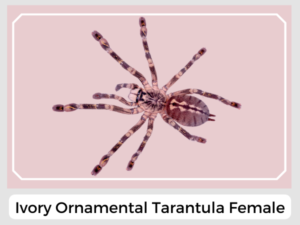Meet the ivory ornamental tarantula! This unique spider loves to climb trees in Sri Lanka. With a quick pounce, they catch their food. Join us to discover cool facts about this amazing tree-loving spider!
The eggs of this tarantula are bright orange.
The spiderlings are brown and covered with setae. After maturing, they will start resembling the adults.
They create an asymmetrical tunnel web, visible only at night.
Yes, Ivory Ornamental tarantulas have venom. It is quite potent, causing severe localized damage if injected via a bite.
Ivory Ornamental tarantulas are incredibly agile and capable of delivering a nasty bite. They might bite if they feel cornered, but they’re mostly focused on their tree-climbing and hunting.
As a crucial component of their ecosystem, the ivory ornamental tarantula helps maintain insect populations. Their nocturnal tree-climbing hunts showcase their role as both predator and prey within the forest’s food web.
Natural Predators: Despite their venom, these tarantulas are not without threats. Birds of prey and larger reptiles often prey on them, maintaining the delicate balance of the ecological hierarchy.
Prey-Predator Dynamics: Their diet comprises various insects, making them essential in regulating insect abundance and preventing overpopulation, which could otherwise lead to crop damage and spread of disease.
Relationship with Humans: Humans rarely encounter ivory ornamental tarantulas, and their venom, though potent, is not lethal to humans. In fact, their presence signifies a healthy, undisturbed habitat, critical for biodiversity conservation.
| Other names | Montane tiger spider, Ivory-billed ornamental tarantula |
| Lifespan | Males: 4 years, Females: 15 years |
| Distribution | Sri Lanka |
| Habitat | Mountainous or lowland forests |
| Diet | Crickets, locusts, moths, roaches, and super worms |

In summary, the ivory ornamental tarantula is a key player in its ecosystem, reflecting the rich biodiversity of Sri Lanka’s forests.
Meet the ivory ornamental tarantula! This unique spider loves to climb trees in Sri Lanka. With a quick pounce, they catch their food. Join us to discover cool facts about this amazing tree-loving spider!
The eggs of this tarantula are bright orange.
The spiderlings are brown and covered with setae. After maturing, they will start resembling the adults.
They create an asymmetrical tunnel web, visible only at night.
Yes, Ivory Ornamental tarantulas have venom. It is quite potent, causing severe localized damage if injected via a bite.
Ivory Ornamental tarantulas are incredibly agile and capable of delivering a nasty bite. They might bite if they feel cornered, but they’re mostly focused on their tree-climbing and hunting.
As a crucial component of their ecosystem, the ivory ornamental tarantula helps maintain insect populations. Their nocturnal tree-climbing hunts showcase their role as both predator and prey within the forest’s food web.
Natural Predators: Despite their venom, these tarantulas are not without threats. Birds of prey and larger reptiles often prey on them, maintaining the delicate balance of the ecological hierarchy.
Prey-Predator Dynamics: Their diet comprises various insects, making them essential in regulating insect abundance and preventing overpopulation, which could otherwise lead to crop damage and spread of disease.
Relationship with Humans: Humans rarely encounter ivory ornamental tarantulas, and their venom, though potent, is not lethal to humans. In fact, their presence signifies a healthy, undisturbed habitat, critical for biodiversity conservation.
| Other names | Montane tiger spider, Ivory-billed ornamental tarantula |
| Lifespan | Males: 4 years, Females: 15 years |
| Distribution | Sri Lanka |
| Habitat | Mountainous or lowland forests |
| Diet | Crickets, locusts, moths, roaches, and super worms |

In summary, the ivory ornamental tarantula is a key player in its ecosystem, reflecting the rich biodiversity of Sri Lanka’s forests.